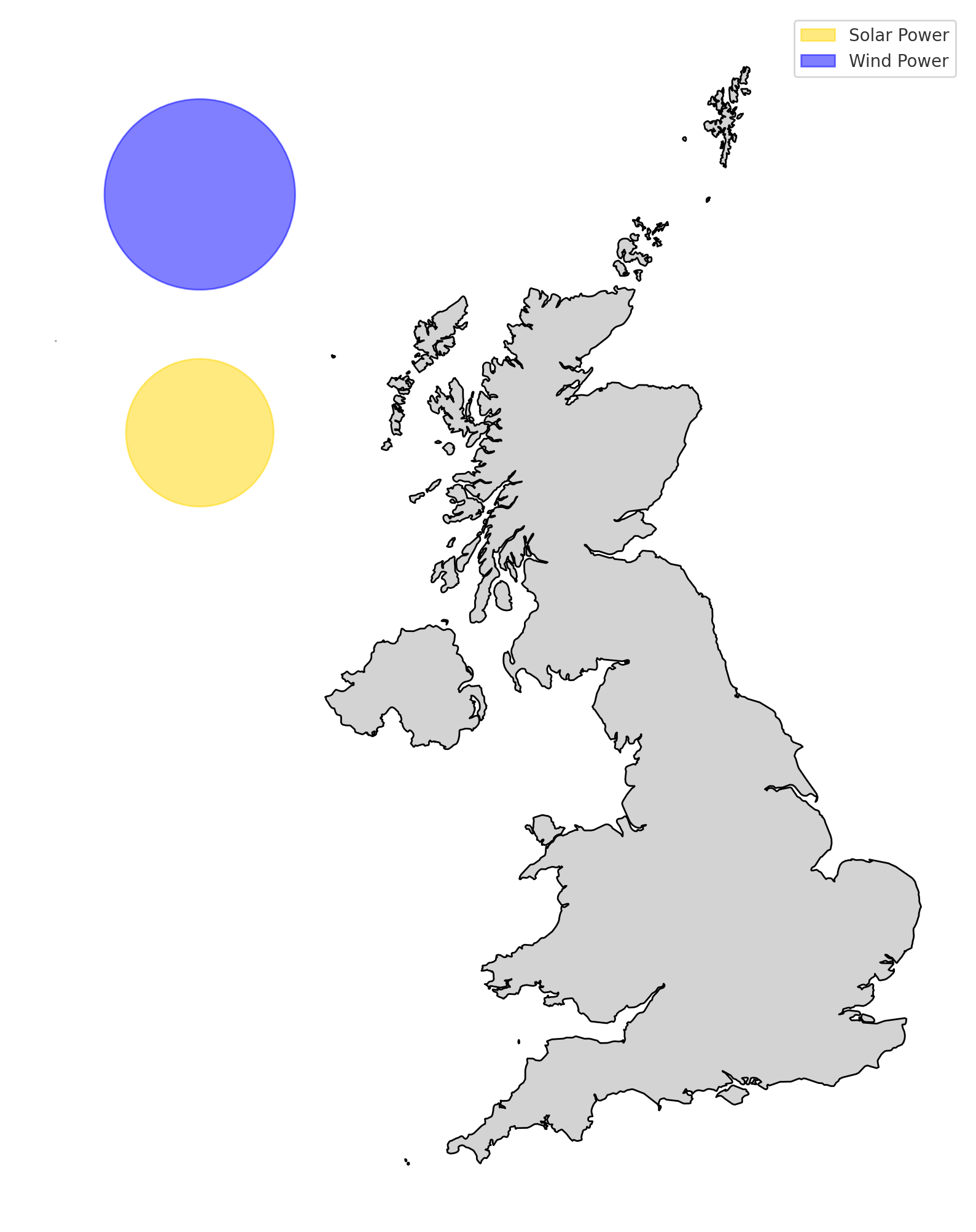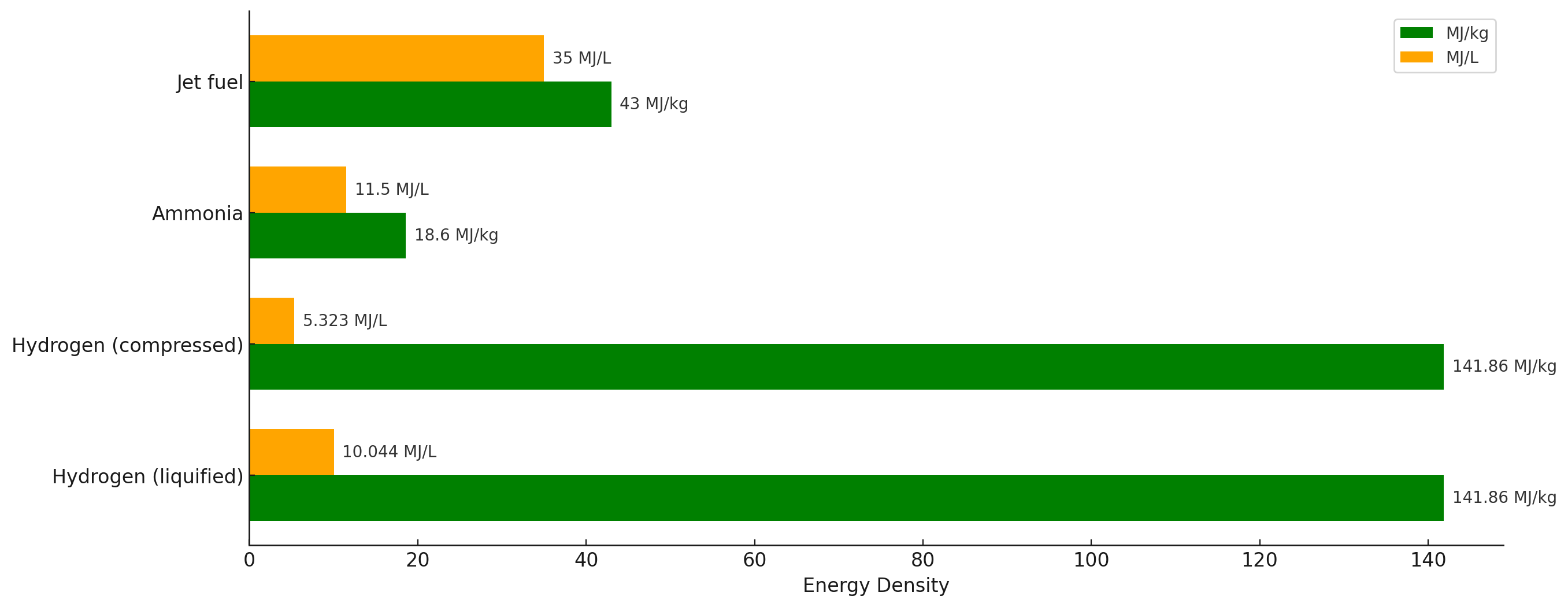Decarbonising the World's Second Biggest Jet Fuel Market
In February the Royal Society published a report on decarbonising the UK market for aviation fuels, which is apparently the second largest in the world. The authors sensibly disregard electric planes as not energy-dense enough to displace the vast majority of aviation fuel consumption, and instead investigate four alternative fuel sources: hydrogen, ammonia, biofuels, and efuels. The headline conclusions are:
- biofuels are a drop-in replacement, but would require half of the UK’s agricultural land for fuel crops
- hydrogen would require a retrofit or replacement (in my opinion probably a complete replacement) of the current aviation fleet, and 207-290TWh of renewables generation per year (2.4-3.4x what’s currently deployed)
- ammonia would require a retrofit or replacement of the current aviation fleet, and 217-332TWh of renewables (2.5-3.9x currently deployed renewables)
- efuels are a drop-in replacement, and would require 468-660TWh of renewables generation per year (5-8x currently deployed renewables)
But they also say they expect the market for aviation fuel to increase to 17m tonnes from it’s 2019 value of 12.3m tonnes, and those numbers assume 2019-level demand. So actually the estimate for the upper bound of these numbers is:
- Hydrogen: 400TWh
- Ammonia: 458TWh
- Efuels: 910TWh
I think the renewables numbers here are kind of dry. They’ve made an attempt to contextualise them by comparing them to the amount of renewables we’ve got now, but I’m not sure many people can reel those numbers off the top of their head. So let’s try to get a better idea of just how daunted we should be by a number like 910TWh.
Do we have enough sun and wind for these plans?
Yes. The biggest number here, 910TWh/year, which works out to 104GW of average power (and, handily, we don’t have to worry about intermittency), assuming a capacity factor of 30% we’d need 346GW of wind turbine capacity to make this work. The UK has potential for 1,800GW of offshore wind capacity (439GW fixed, 1,361GW floating), so we’d only need to utilise 19% of that to get enough energy for our worst case scenario. For context, aviation fuel accounted for around 7% of the UK’s energy consumption in 2019 (we used 12.3m tonnes, or 147TWh of fuel, and our primary energy consumption was 2,185TWh—there will be some energy lost converting oil to kerosene, but I don’t think it affects the calculation too much).
How much space will it take up?
Let’s assume a 50/50 split of wind and solar power; where wind has a capacity factor of 30% and we can deploy 4.5MW/km2; and solar has a capacity factor of 10% and we can deploy 50MW/km2. I’m pretty persuaded by the argument that, as the cost of renewable energy continues to fall, low-capex, low-efficiency production processes will start to look more apealling, so I’m going to assume the “worst-case” energy requirements, as they may turn out to be the best-case in terms of cost.
I gave ChatGPT code interpreter a GeoJSON file for the UK, and asked it to visualise these areas as circles on a map. Then I watched YouTube videos and tabbed back to the interpreter every now and then to prod it into changing things until I got these maps that show the amount of area needed for renewables for each fuel source:



And then I also got our AI overlord to make this chart comparing the different fuels by cost, because I’ve never really like Excel.

So far everything we’ve looked at has told the story: hydrogen best, efuels worst, ammonia middlest. This shouldn’t surprise us. The starting point for all of these processes is to produce hydrogen with electrolysis. After that you can use the Haber-Bosch process, which uses nitrogen from the air, and quite a bit more energy, to produce ammonia; or you can use the Fischer-Tropsch process, which uses carbon dioxide from the air, and a hell of a lot more energy, to produce synthetic paraffinic kerosene (efuel). So let’s now take a look at energy density, where—in the case of volumetric density (MJ/L), at least—that changes:

Hydrogen’s gravimetric energy density is very good, in fact it’s the best of any chemical in an oxidation reaction. But, volumetrically, it looks bad. Litre-for-litre jet fuel has more than 3x the energy of liquified hydrogen, and 6x that of compressed hydrogen. And this matters, especially when you consider that extremely compressed (the figures for compressed hydrogen assume 681atm of pressure!), or liquified hydrogen requires very strong, or very insulated fuel tanks. Generally these will have to be cylindrical, and very large. So rather than storing fuel in the otherwise-unused space in the wings, hydrogen tanks end up looking like this:

The story for ammonia isn’t nearly as bad, as it can be liquified at either 10 atmospheres of pressure, or -33C°C. I’m not really sure how viable it would be to put ammonia tanks in aeroplane wings, but given its comparatively terrible energy density compared to jet fuel, I suspect at least some of it would have to go in the fuselage. Did I mention it’s also toxic and corrosive? Here’s the Royal Society report…
[ammonia] is classed as a toxic gas and a corrosive substance that causes irritation and it represents a chronic hazard to terrestrial ecosystems as well as providing an increasing burden to air pollution.
I don’t entirely rule out that aviation ammonia could be a thing, but I’m not holding my breath… unless it leaks.
I really don’t know enough about aviation to know how practical it would be to retrofit a kerosene-powered plane with fuselage-mounted hydrogen tanks, but at the very least it seems like the lower energy density will mean a significant hit to the performance of the plane, as a result of some combination of lower range, or reduced fuselage space I haven't even mentioned that, as well as finding space for a fuel tank, retrofitting for hydrogen would mean replacing a plane's engines too!
. For this reason a lot of hydrogen plane concepts have blended wing body (BWB) designs like this one, also from Airbus:

This design is a lot more aerodynamically efficient than the conventional “tube-and-wing” design for a given interior volume, so it could potentially be a solution to hydrogen’s volume problem, if airlines choose replacement over retrofitting So far no BWB aircraft have made it to the civilian market, they're held back by problems like the fact they're not passively stable, and don't have great places to put windows. But if these problems could be overcome then BWBs wouldn't be limited to hydrogen power, and designers would likely use whichever fuel source proves cheapest.
. But modern airliners have a service life of 30 years or more, so economically replacing the global fleet by 2050 would technically mean getting started 3 years ago. Meanwhile Airbus is aiming to bring its first hydrogen plane to market in 2035, and even then they’ve stated that’s unlikely to be a BWB design. As far as I can tell Boeing haven’t bothered
to announce a timeline.
Even if the first hydrogen-powered planes start rolling off the production line in 2035, manufacturers won’t be able to come up with replacements for their entire range in one go. It might take until 2050, or longer, just to bring like-for-like replacements for existing aircraft categories to market. So if conventionally powered planes are being sold until then, and have 30-year service lives, we might need jet fuel until at least 2080.
It might seem like this picture assumes a laissez-faire approach where governments allow airlines to do whatever is cheapest, environment be damned, but that isn’t necessarily the case. If, say in 2050, governments tell airlines they must use net-zero fuels—but remain agnostic as to which type they use—then they can decide for themselves whether that they’re better off running their existing fleet on efuels, or buying new planes.
Honestly, I think they’re just going to use the efuels. There’s are good reasons we use kerosene currently: it’s got impressive energy per kg, and per liter; and as a liquid it’s incredibly easy to transport, store, handle and fly with. If we had to do it all again, we’d probably choose efuels. But we don’t have to do it all again, we’ve already got an efuel-ready aviation fleet waiting to go! The only reason alternatives are being discussed at all is that the energy requirements for producing efuels are probably more than 2x greater than the energy requirements for hydrogen alone. But modern solar power produces the cheapest energy the world has ever seen, and it’s still getting cheaper. On the other hand bringing new aircraft to market remains expensive, presumably doubly so for aircraft that are a radical departure from the norm, so it’s going to make sense to keep complexity on the ground where possible.
What I think is far less certain about the UK’s path to decarbonising aviation fuels is whether or not we outsource this problem. To look into this let’s assume that we want to import kerosene produced in Morocco, and that Morocco’s solar prices are among the cheapest in the world. The cheapest solar prices in the world are about $24/MWh, which is roughly half of the £41/MWh ($56/MWh) the UK government predicts solar will cost in 2025. The royal society report estimates that efuels using direct air capture will cost £94.50/GJ. If we assume that halving the cost of energy halves the cost of efuels, then shipping efuels from Morocco has to cost less than £47.25/GJ to be competitive. Shipping crude oil across the Atlantic climbed to $5/barrel in the wake of the Ukraine war, assuming kerosene-shipping costs are similar, and a journey across the Atlantic is 5,500km then it costs $0.90/barrel/1000km to ship kerosene. Plugging in the energy density of kerosene, that works out to $0.16/GJ/1000km. Morocco to the UK is about 2,000km so, very roughly, we can expect a GJ of kerosene from Morocco to cost £47.41, against a UK GJ’s £94.50. So even though my calculations are pretty hand-wavy, I feel pretty confident that importing kerosene that’s been made in the desert—any desert really—will be lower than producing it in the UK.
In light of recent events, I find this reliance on other countries, who might not always be friendly to us, kind of depressing. But the good news is that if we want to run our grid on renewables we’re going to have to overbuild them, and if we overbuild wind and solar there will be times when there’s grid electricity going spare. I’m not sure how much jet fuel this would realistically buy us, but this post is already too long, so I guess that’s something I might try to look into in a future post.